A series of timelapse maps lay bare how the Delta Covid variant has rapidly engulfed every corner of the UK since exploding onto the scene in spring — with Northern Ireland and Scotland being hit hardest.
Data from the Government’s coronavirus dashboard shows that even areas which were virtually coronavirus-free just four months ago are now recording some of the highest infection rates in the country.
The UK is averaging more than 33,000 new infections every day, which is the highest since the second wave was still raging in January, excluding a blip during Euro 2020 when cases briefly rose above that number.
And while hospital admissions and deaths are still at a fraction of the level in winter, there are concerns that high levels of Covid in the community and waning vaccine immunity could spill into more casualties.
The maps show that, despite the ultra-infectious Delta strain being seeded in England in late April, it is actually Scotland and Northern Ireland that now appear to be bearing the brunt of the third wave.
All 10 of the highest Covid infection rates in the past week were in local authorities in Northern Ireland and the Scottish central belt.
Fermanagh and Omagh, which covers most of the Southwest of Northern Ireland, had a rate of 1,056 cases per 100,000 in the seven days to August 25 — three times the UK average. It was followed by Derry City and Strabane (986).
Rounding out the top 10 worst-hit areas were all places in Scotland, with West Dunbartonshire (983), East Dunbartonshire (975) and North Lanarkshire (913) seeing the highest prevalence.
The rise in Scotland has been attributed to increased mixing in schools after the summer holidays finished in mid-August, and there are fears England and Wales could be next when classes go back this week and next.
It is not clear exactly why Northern Ireland is being hit so hard this time around because schools are not due to restart there until this week, either. But the country has the lowest vaccine uptake in the UK with about 82 per cent of adults having received at least one jab.
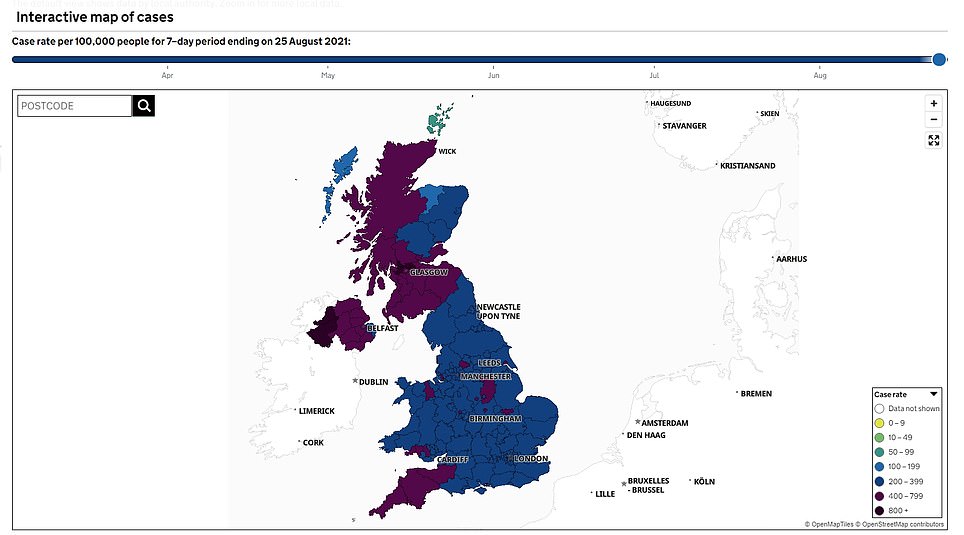
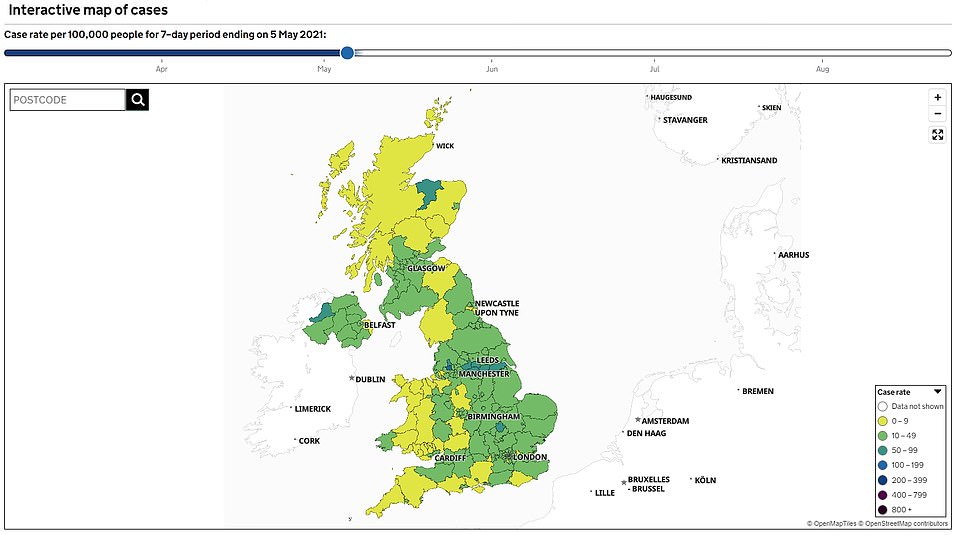 ‹ Slide me ›
‹ Slide me ›
A series of maps today laid bare how the Delta Covid variant has rapidly engulfed every corner of the UK since exploding onto the scene in spring. Even areas which were virtually coronavirus-free just four months ago are now recording some of the highest infection rates in the country
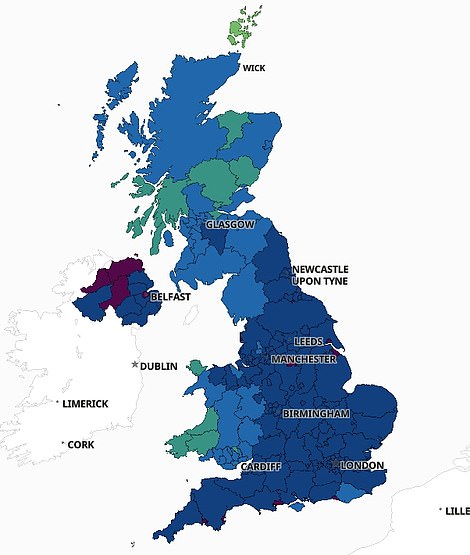
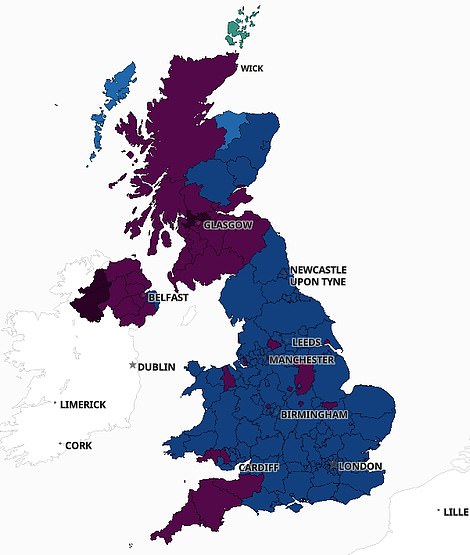
There were still flashes of green in some parts of the UK on August 4 – representing fewer than 50 per 100,000 weekly cases. But by August 25 the map was awash with blue and purple, with no area recording fewer than 100. Dark purple shows rates above 800
Thanks to the Covid vaccine rollout, the UK is recording, on average, 115 Covid deaths per day and around 900 daily hospital admissions.
That is 10 times fewer fatalities than in late January when infections were last this high and around a quarter of the number of hospitalisations. But both metrics have been rising steadily over summer.
Nicola Sturgeon last week said she would not hesitate to put Scotland in another lockdown if admissions start to follow the sharp rise in cases in the past fortnight since schools went back.
The infection rate in Scotland more than doubled in the week after the restart which has left even rural parts of the country with worryingly high levels of transmission.
In Argyll and Bute, for example, on the west coast, there were just one case per 100,000 people in the week up to May 5 when the Delta variant was starting to spread. The area was recording 708 per 100,000 by the most recent count on August 25.
Rural parts of England have also been hit hard this time around, believed to be due to the rise in staycations and lower immunity in the less populated countryside.
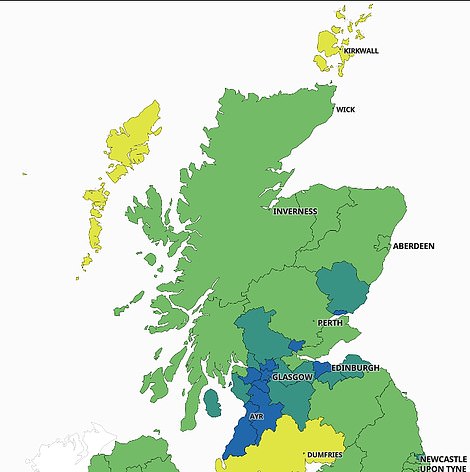
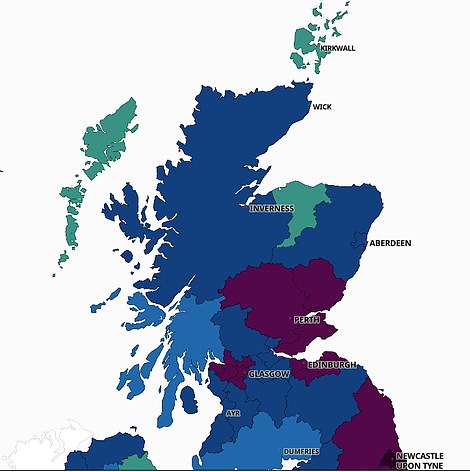
SCOTLAND: Infection rates had been low in most of Scotland, with some exceptions in the central belt, in June after months of lockdown and a successful vaccine rollout (shown on June 2, left) but the Delta variant quickly raced through the population by July 7 (right)

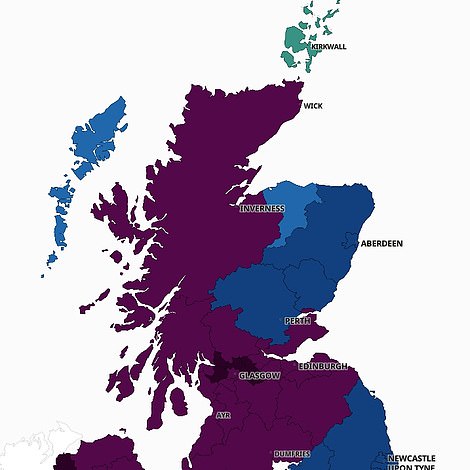
SCOTLAND: The maps show the situation north of the border on August 4 (left) when schools were off for summer versus August 25, a week after they’d been back
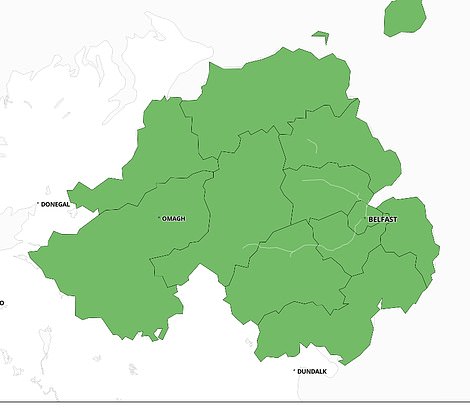
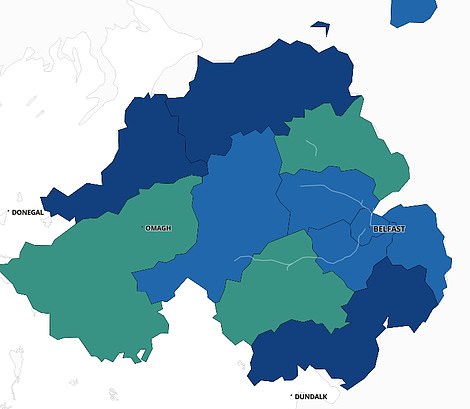
NORTHERN IRELAND: Relatively low vaccine uptake in Northern Ireland is believed to be playing a role in the rapid rise in cases there (June 2 vs July 7)

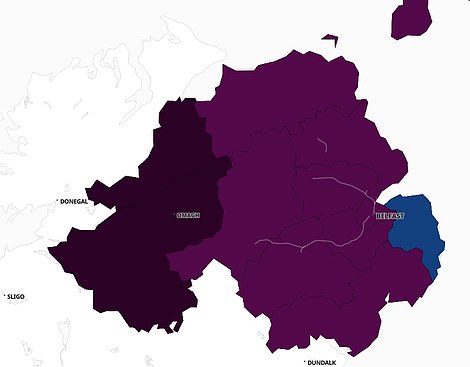
NORTHERN IRELAND: By August 4 (left) the nation’s six counties were already recording more than 200 cases per 100,000. By August 25 virtually all areas had a rate of more than 400
UK’s daily Covid infections fall by 17% in a week to 26,476 as deaths rise by a fifth to 48
Britain’s daily Covid cases fell by 17 per cent in a week to 26,476 yesterday but deaths continued to rise.
The drop in positive tests – the first of its kind in a fortnight – will largely be down to a Bank Holiday recording lag. No data was available for Wales, which is posting around 2,000 infections every day currently.
However, infections have been falling in England – which makes up the bulk of Britain’s daily figures – for several days. Scotland posted fewer cases than expected but Northern Ireland’s tally was similar to those seen over the past week.
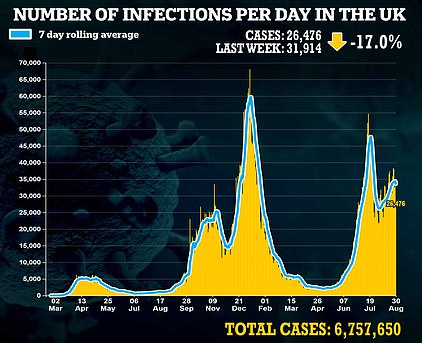
No hospitalisation statistics were published for the UK. But there was a 20 per cent jump in deaths – which can lag weeks behind cases because of how long it takes for infected patients to become severely ill. Another 48 victims were added to the Government’s official toll today, up from 40 last Monday.
Counts on Mondays are always artificially low because of the weekend recording lag. Tomorrow’s fatality tally is expected to be lower than normal because of Bank Holiday-induced delays, too.
Scientists actually fear the tens of thousands of revellers who headed out to festivals such as Reading and Leeds over the weekend will have triggered a huge uptick in infections, which won’t be seen in the official numbers until later this week and next.
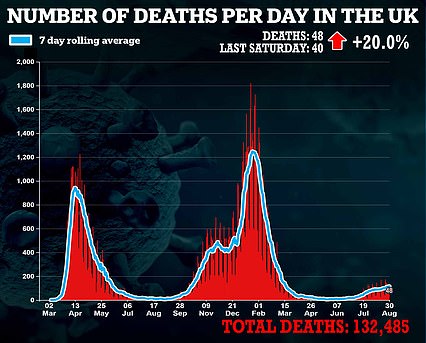
Other experts have warned case rates will start to spike in England later this week and next because of children going back to school after the summer holidays.
Infections have already spiralled to record highs in Scotland, with the uptick largely blamed on the reopening of classrooms following the summer holidays.
Advertisement
Cornwall, which was the country’s Covid hotspot earlier this month, is recording nearly 670 cases per 100,000 now compared to just 5 per 100,000 back in May.
Nationally, there are also concerns about how long vaccines protect people for after a major study by King’s College London last week found two doses of both Pfizer and AstraZeneca’s jabs started to wane within six months.
The NHS is also expected to be stretched thin this winter when Covid finds it easier to spread and the health service faces normal pressures.
And a bad flu season has also been predicted, due to the lack of natural immunity gained over the past year amid repeated lockdowns.
Teaching unions today warned England could be forced into re-adopting tougher Covid measures ‘very shortly’ when millions of youngsters will go back to classrooms this week and next.
As part of the Government’s strategy of learning to live alongside the virus, ministers dropped the remaining infection-controlling restrictions in English schools.
It means that children no longer have to wear masks in class, nor do they have self-isolate if another pupil in their ‘bubble’ tests positive. Twice-weekly lateral flow tests is the only measure being kept from last term.
But in Scotland — which has seen cases spiral to record highs since children went back in mid-August — masks are still required for the next few weeks, and staff must keep a one-metre gap between each other and pupils.
Experts yesterday warned that England faces an even ‘worse’ uptick following the return of schools because of the lack of protective restrictions. The country also has a higher Covid infection rate than Scotland did when classes reopened north of the border.
Mary Bousted, the joint general secretary of the National Education Union, said: ‘We have much higher prevalence now in the community than it was.
‘We’re going in with much higher rates of prevalence into schools where we are relying on one mitigation, which is lateral flow testing. In Scotland they have not abandoned the safety precautions.
‘My prediction is very shortly we are going to see schools all over the country in their hundreds having to operate contingency framework.’
Ms Bousted told the Daily Telegraph: ‘But what you’re doing there is shutting the stable door after the Covid horse has bolted.’
Scotland was recording around 2,000 cases a day on August 16 when its schools started to return. This equated to an infection rate of 250 positive tests for every 100,000 people each week.
But in the last week it has broken its record for the highest number of daily cases registered four times.
Scotland posted more than 7,000 new infections on Sunday — more than three times above the levels seen during the darkest days of the second wave. Its infection rate is now 580 per 100,000.
In England there are already more than 20,000 cases a day, with an infection rate of around 320 positive tests per 100,000 people.
The country’s outbreak has tailed off over the past week but experts have always warned the return of schools would trigger an uptick.
When 8.9million children in England went back last September it led to Covid cases spiking four-fold in a month.
And they spilled over into older age groups, who are more vulnerable to the disease.
Dr Deepti Gurdasani, an epidemiologist at Queen Mary University of London and member of Independent SAGE, said yesterday: ‘Scotland is proving to be a cautionary tale of what happens when restrictions are dropped and then schools reopened without adequate mitigations.
‘We can expect worse in England in the near future.
‘Let’s remember schools in England won’t even have the few mitigations that are present in Scotland. So no masks, no ventilation, no distancing, no contact tracing in schools. This is a recipe for disaster.’

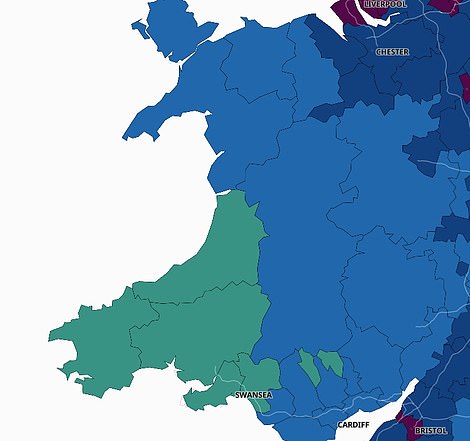
WALES: How infection rates in Wales have changed from June 2 to July 7. There are fears of a ‘big bang’ in cases when schools restart this week and next
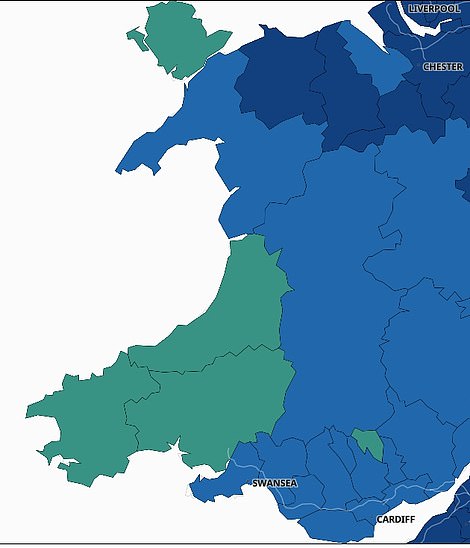
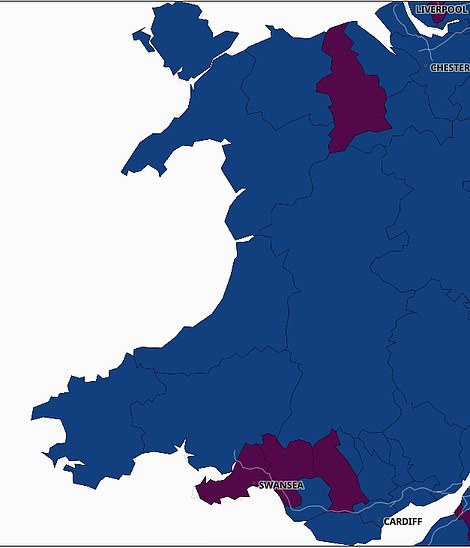
WALES: How infection rates in Wales changed between August 4 and August 25
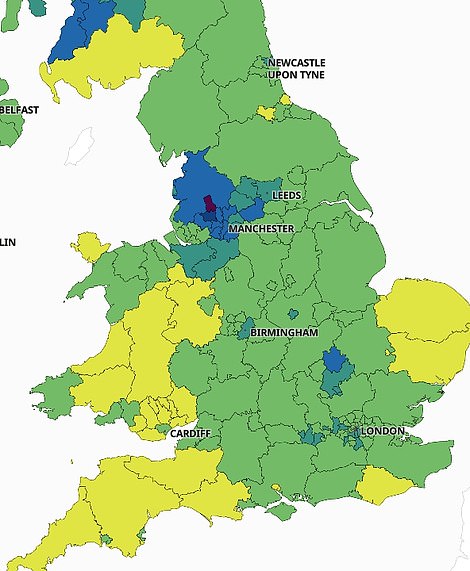
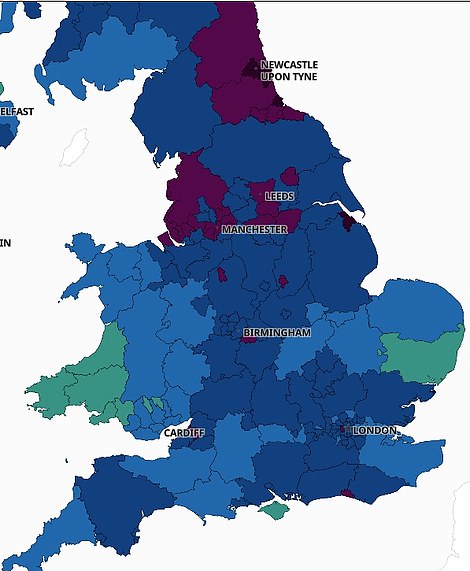
ENGLAND: The mutant Delta variant was first seeded in England in late April and May, which saw parts of London and Manchester to see spikes by June 2 (left). The highly infectious strain then swept the country rapidly by July 7 (right)
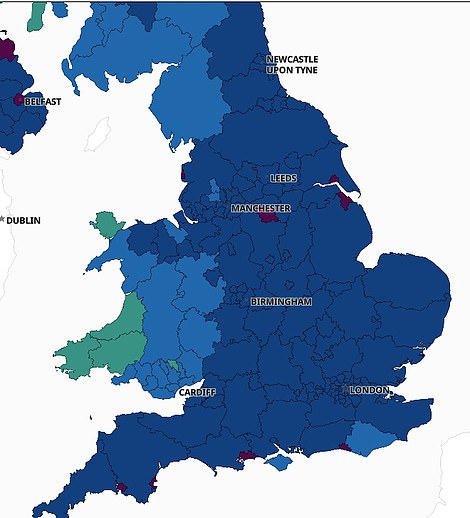
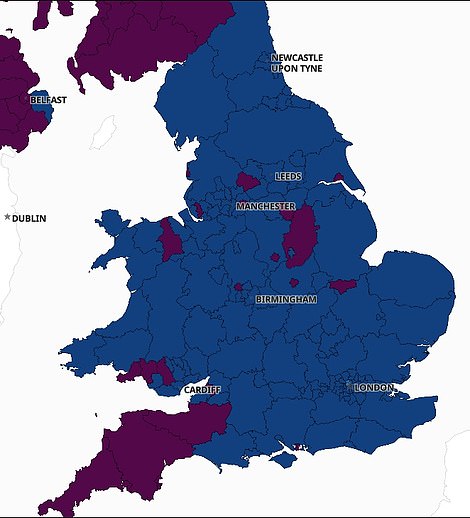
ENGLAND: How infection rates in England have changed since August 4 (shown left)
England will suffer a WORSE Covid outbreak than Scotland following the return of children to schools, experts fear
England faces an even worse spike in Covid cases than Scotland when children return to schools, top scientists warned.
Infections have already spiralled to record highs north of the border, with the uptick blamed on the reopening of classrooms following the summer holidays.
And now there are fears England — which has higher background rates of Covid than Scotland did — could be hit even harder, with millions of schoolchildren set to go back later this week and next.
Teaching unions are furious social distancing restrictions such as mask-wearing have been dropped in England, which experts have branded a ‘recipe for disaster’ — but Scotland is keeping them until the end of September.
Education Secretary Gavin Williamson has urged parents to step in to save the country from a fourth wave by testing their children twice a week for the virus.
Dr Deepti Gurdasani, an epidemiologist at Queen Mary University of London and member of Independent SAGE, said: ‘Scotland is proving to be a cautionary tale of what happens when restrictions are dropped and then schools reopened without adequate mitigations. We can expect worse in England in the near future.’
The most up-to-date data from the Office for National Statistics, which carries out tens of thousands of random swab tests to track the size of the outbreak, shows one in 50 secondary school-age children were infected with Covid in mid-August.
Advertisement
Dr Kit Yates, a mathematician at Bath University and fellow Independent SAGE member, tweeted that the impact of reopening schools on Covid cases would be ‘potentially disastrous’.
He said: ‘We will see cases rise in young people, but also in older age groups with all the attendant consequences (illness, hospitalisations and deaths and long Covid).’
‘We’ve had so long to do something about this, yet in recent months we have actually gone backwards (removing masks, bubbles, isolation of contacts, etc).’
Schools in parts of the South West will still ask pupils to wear masks in corridors, playgrounds and ‘communal areas’ when they return.
Meanwhile, one school in Rotherham has pledged to defy Government guidance.
Wales High School in the South Yorkshire town will maintain masks and support bubbles when pupils return to the classroom this week.
Headteacher Pepe Di’Iasio told BBC Radio 4’s Today programme: ‘We’re maintaining masks in crowded corridors, and in social areas because we feel that that will help keep the infection rates down.
‘But we’re also maintaining some of the pre-Covid rules of our one-way systems, and our separation of year groups that were formerly known as bubbles and they’re now just going to be kept in new groups again to try and just keep crowds down and keep the numbers apart.’
There is no national guidance on wearing masks in schools, with all the remaining restrictions dropped in May.
The bubble system, which saw pupils eat with the same group every day to stop the virus spreading, was also scrapped.
No10’s Education Secretary has, however, said schools should consider keeping children in lunch ‘bubbles’ this term to improve behaviour.
Gavin Williamson is encouraging headteachers to extend the Covid measures because it has other benefits beyond restricting the virus.
But Mr Williamson said schools found it a great opportunity to teach ‘family dining’ – including table manners and social skills.
Writing for the Mail, he also urged parents to encourage their children to get regularly tested and to ensure they don’t get ‘carried away’.
Pupils will have to get tested twice at school on the first week of their return, under the Department of Education’s guidance. They should carry out two lateral flow tests a week at home thereafter.
Those who test positive will need to isolate for ten days. But other children they sit next to in the classroom will no longer need to isolate as well as part of the Government’s pledge to end quarantine restrictions.
Mr Williamson said: ‘The last thing we want is for schools to partially close again, or for whole classes of pupils to be at home self-isolating.’
During the previous academic year schools were launched into Covid chaos with some sending whole year-groups home after just one positive test.
Official figures show that at the end of the last academic year 750,000 children had been sent home to self-isolate, despite there being only 40,000 positive tests.
Lobby groups have blamed over-cautious teachers and staff for sending so many children home, and welcomed the Government’s decision to relax most Covid restrictions this year.
But teaching unions have already warned that school are set to be plunged into ‘chaos’ again in the weeks ahead should cases spiral rapidly.
It comes after a survey last night showed the majority of parents want longer school days to help their children recover from Covid disruption.
Fifty-one per cent of parents support pupils spending extra time each day on activities such as sport and drama.
Only a fifth were opposed to the proposal – championed by the Centre for Social Justice think-tank, according to the YouGov poll.
Source link : https://www.dailymail.co.uk/news/article-9942981/Timelapse-maps-reveal-Scotland-Northern-Ireland-bearing-brunt-Covid-wave.html











